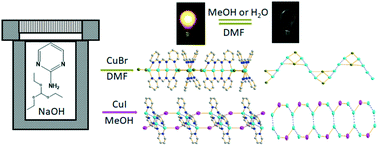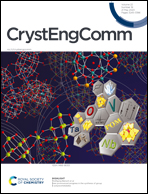One-dimensional chains based on linear tetranuclear copper(i) units: reversible structural transformation and luminescence change†
Abstract
One-pot solvothermal reactions of 2-aminopyridine, triethylorthoformate and sodium hydroxide with CuX (X = Br, and I) in dimethylformamide (DMF) and methanol (MeOH) afforded extended metal chains based on the linear tetracopper units, {[Cu4Br2(Dpyf)2]·DMF}n, 1, and [Cu4I2(Dpyf)2]n, 2, which were structurally identified by X-ray crystallography. Complexes 1 and 2 present closed-shell Cu(I)–Cu(I) interactions that are supported by formamidinate ligands, resulting in a face-to-side configuration and a face-to-face configuration, respectively, for the tetranuclear units. Complexes 1 and 2 represent the first example of one-dimensional (1D) coordination polymers that are based on linear tetracopper units. Moreover, complexes 1 and 2 can be regarded as copper(I) halide aggregates with the unique Cu4Br22+ and Cu4I22+ cations extending into a 1D zigzag chain and a looped chain, respectively. Complexes 1 and 2 show broad emissions at 570 and 549 nm, respectively, which can most probably be ascribed to 3d(Cu) → π* metal to ligand charge transfer. Reversible crystal-to-crystal transformation and luminescence change were observed for complex 1 upon solvent exchange, which can be regarded as a potential luminescent sensor for selective detection of water and methanol.



 Please wait while we load your content...
Please wait while we load your content...